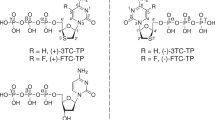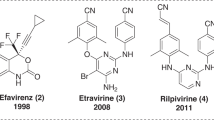Abstract
Nucleoside-based inhibitors of reverse transcriptase were the first drugs to be used in the chemotherapy of AIDS. After entering the cell, these substances are activated to their triphosphate form by cellular kinases, after which they are potent chain terminators for the growing viral DNA (ref. 1). The two main factors limiting their efficacy are probably interrelated. These are the insufficient degree of reduction of viral load at the commencement of treatment and the emergence of resistant variants of the virus. The reason for the relatively poor suppression of viral replication appears to be inefficient metabolic activation. Thus, for the most extensively used drug, 3′-azido-3′-de-oxythymidine (AZT), whereas phosphorylation to the monophosphate is facile, the product is a very poor substrate for the next kinase in the cascade, thymidylate kinase2,3. Because of this, although high concentrations of the monophosphate can be reached in the cell, the achievable concentration of the active triphosphate is several orders of magnitude lower. Determination of the structure of thymidylate kinase as a complex with AZT monophosphate (AZTMP) together with studies on the kinetics of its phosphorylation have now led to a detailed understanding of the reasons for and consequences of the poor substrate properties.
This is a preview of subscription content, access via your institution
Access options
Subscribe to this journal
Receive 12 print issues and online access
$209.00 per year
only $17.42 per issue
Buy this article
- Purchase on Springer Link
- Instant access to full article PDF
Prices may be subject to local taxes which are calculated during checkout
Similar content being viewed by others
References
Tornevik, Y., Ullman, B., Balzarini, J., Wahren, B. & Eriksson, S. Cytotoxicity of 3′-azido-3′-deoxythymidine correlates with 3′-azidothymidine-5′-monophosphate (AZTMP) levels, whereas anti-human immunodeficiency virus (HIV) activity correlates with 3′-azidothymidine-5′-triphosphate (AZTTP) levels in cultured CEM T-lym-phoblastoid cells. Biochem. Pharmacol. 49, 829–837 (1995).
Furman, P.A. et al. Phosphorylation of 3′-azido-3′-deoxythymidine and selective interaction of the 5′-triphosphate with human immunodeficiency virus reverse transcriptase. Proc Natl. Acad. Sci. USA 83, 8333–8337 (1986).
Qian, M., Bui, T., Ho, R.J. & Unadkat, J.D. Metabolism of 3′-azido-3′-deoxythymi-dine (AZT) in human placental trophoblasts and Hofbauer cells. Biochem. Pharmacol. 48, 383–389 (1994).
Lavie, A. et al. Crystal structure of thymidylate kinase reveals the cause behind the limiting step in AZT activation. Nature Struct. Biol. (in the press).
Saraste, M., Sibbald, P.R. & Wittinghofer, A. The P-loop — a common motif in ATP-and GTP-binding proteins. Trends Biochem. Sci. 15, 430–434 (1990).
Frick, L.W., Nelson, D.J., St Clair, M.H., Furman, P.A., Krenitsky, T.A. Effects of 3′-azido-3′-deoxythymidine on the deoxynucleotide triphosphate pools of cultured human cells. Biochem. Biophys. Res. Commun. 154, 124–129 (1988).
Van, J.P. et al. 3′-Azidothymidine (zidovudine) inhibits glycosylation and dramatically alters glycosphingolipid synthesis in whole cells at clinically relevant concentrations. J. Biol. Chem. 270, 22836–22841 (1995).
Bridges, E.G., Faraj, A. & Sommadossi, J.P. Inhibition of mammalian DNA poly-merase-associated 3′ to 5′ exonuclease activity by 5′-monophosphates of 3′-azido-3′-deoxythymidine and 3′-amino-3′-deoxythymidine. Biochem. Pharmacol. 45, 1571–1576 (1993).
Harrington, J.A., Reardon, J.E. & Spector, T. 3′-Azido-3′-deoxythymidine (AZT) monophosphate: An inhibitor of exonucleolytic repair of AZT-terminated DNA. Antimicrob. Agents Chemother. 37, 918–920 (1993).
Miiller, B., Restle, T., Reinstein, J. & Goody, R.S. Interaction of fluorescently labeled dideoxynucleotides with HIV-1 reverse transcriptase. Biochemistr. 30, 3709–3715 (1991).
Goody, R.S., Muller, B. & Restle, T. Factors contributing to the inhibition of HIV reverse transcriptase by chain-terminating nucleotides in vitro and in vivo. FEBS Lett. 291, 1–5 (1991).
Nickel, W., Austermann, S., Bialek, G. & Grosse, F. Interactions of azidothymidine triphosphate with the cellular DNA polymerases alpha, delta, and epsilon and with DNA primase. J. Biol. Chem. 267, 848–854 (1992).
Huang, P., Farquhar, D. & Plunkett, W. Selective action of 3′-azido-3′-deoxythymi-dine 5′-triphosphate on viral reverse transcriptases and human DNA polymerases. J. Biol. Chem. 265, 11914–11918 (1990).
Clos, J. et al. Molecular cloning and expression of a hexameric Drosophila heat shock factor subject to negative regulation. Cell 63, 1085–1097 (1990).
Studier, F.W., Rosenberg, A.H., Dunn, J.J. & Dubendorff, J.W. Use of T7 RNA poly-merase to direct expression of cloned genes. Methods Enzymol. 185, 60–89 (1990).
Berghäuser, J. Identification of an active arginine in adenylate kinase. Biochim. Biophys. Acta 397, 370–376 (1975).
Author information
Authors and Affiliations
Rights and permissions
About this article
Cite this article
Lavie, A., Schlichting, I., Vetter, I. et al. The bottleneck in AZT activation. Nat Med 3, 922–924 (1997). https://doi.org/10.1038/nm0897-922
Received:
Accepted:
Issue Date:
DOI: https://doi.org/10.1038/nm0897-922
This article is cited by
-
Deciphering molecular mechanisms underlying chemoresistance in relapsed AML patients: towards precision medicine overcoming drug resistance
Cancer Cell International (2021)
-
Surmounting Cytarabine-resistance in acute myeloblastic leukemia cells and specimens with a synergistic combination of hydroxyurea and azidothymidine
Cell Death & Disease (2019)
-
Differential gene expression in human hepatocyte cell lines exposed to the antiretroviral agent zidovudine
Archives of Toxicology (2013)
-
Transgenic cardiac-targeted overexpression of human thymidylate kinase
Laboratory Investigation (2010)
-
Long-Term Exposure to AZT, but not d4T, Increases Endothelial Cell Oxidative Stress and Mitochondrial Dysfunction
Cardiovascular Toxicology (2009)



